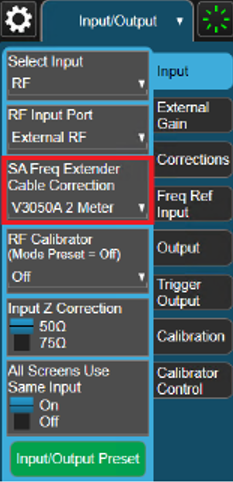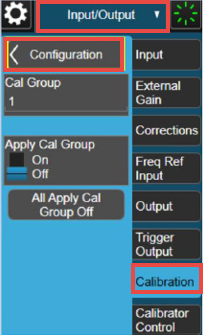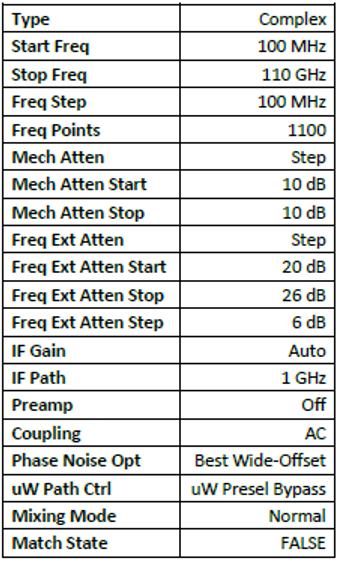
This screen accesses the alignment system of the instrument.

Run Individual Channel Alignment
Clear Individual Channel Alignment
Runs the internal alignment for all channels in the instrument and stores the data if successful. While alignment is running, no other operation of the instrument is allowed.

To maintain instrument accuracy, it is important to keep the instrument aligned. It is recommended to perform this alignment following the initial setup of the instrument, and periodically thereafter.

Energy will be present at the RF Output while alignment runs. Level-sensitive devices must be disconnected before running alignment.
The RF Output can be terminated with a 50-ohm load if you want to eliminate such signals from being broadcast in your test environment.
Once you have selected Internal Alignments for the desired channel, select Run.
|
GUI Location |
System Menu > Settings (gear icon) > Alignment > Internal > Perform Alignment |
| SCPI Command | *CAL? |
| SCPI Exampled | *CAL? |
| Notes |
Returns 0 if successful. Returns 1 if failed. While performing the alignment, the Calibrating bit (bit 0 in the Status Operation register) is set. Completion, or termination, will clear bit 0 in the Status Operation register. This command is sequential; it must complete before further SCPI commands are processed. Interrupting the alignment from remote is accomplished by invoking Device Clear followed by the :ABORt command. With an M1749A connected, alignments will take significantly longer. If running alignments using SCPI, ensure your timeout is set to take this into account. Alignment will be needed after bootup whenever a V3080A’s capabilities have been removed or added since the previous application run, as well as when the V3080A’s serial has changed between application runs. *CAL? is the same as doing a CAL:INT? for all channels |
| Status Bits/OPC Dependencies | Bit 7 in the Status Questionable Register will be clear when the alignment is successful |
|
Initial S/W Revision |
A.01.00 |
Runs the internal alignment for all channels in the instrument and stores the data if successful. While alignment is running, no other operation of the instrument is allowed.
Energy will be present at the RF Output while alignment runs. Level-sensitive devices must be disconnected before running alignment.
The RF Output can be terminated with a 50-ohm load if you want to eliminate such signals from being broadcast in your test environment.
|
GUI Location |
System Menu > Settings (gear icon) > Alignment > Internal Alignment > Perform Alignment |
|
SCPI Command |
*CAL? |
|
SCPI Example |
*CAL? |
|
Notes |
Returns 0 if successful. Returns 1 if failed. While performing the alignment, the Calibrating bit (bit 0 in the Status Operation register) is set. Completion, or termination, will clear bit 0 in the Status Operation register. This command is sequential; it must complete before further SCPI commands are processed. Interrupting the alignment from remote is accomplished by invoking Device Clear followed by the :ABORt command. With M1749A connected, alignments will take significantly longer. If running alignments using SCPI, ensure your timeout is set to take this into account. Alignment will be needed after bootup whenever V3080A’s capabilities have been removed or added since the previous application run, as well as when the V3080A’s serial has changed between application runs. *CAL? is the same as doing a CAL:INT? for all channels. |
|
Initial S/W Revision |
A.01.00 |
Runs the internal alignment for an individual channel in the instrument and stores the data if successful.
|
SCPI Command |
:CALibration<channel>:INTernal? |
|
SCPI Example |
:CAL:INT? ! Aligns channel 1 and returns a value :CAL2:INT? ! Aligns channel 2 and returns a value |
|
Notes |
The subopcode specifies the channel to align. Returns 0 if successful. Returns 1 if failed. While performing the alignment, the appropriate bit(s) in the STATus:OPERation:ALIGning and STATus:OPERation:ALIGning:EALigning registers are set. Completion, or termination, will clear the appropriate bit(s) in the STATus:OPERation:ALIGning and STATus:OPERation:ALIGning:EALigning registers. This command is sequential; it must complete before further SCPI commands are processed. Interrupting the alignment from remote is accomplished by invoking Device Clear followed by the :ABORt command. With M1749A connected, alignments will take significantly longer. If running alignments using SCPI, ensure your timeout is set to take this into account. |
|
Initial S/W Revision |
A.01.00 |
|
Modified S/W Revision |
A.11.50 - added access from the GUI and the per-channel status registers |
For M9484C, it erases internal alignment data stored in memory for all channels, returning the alignment data to what was in place at the time of manufacturing. Alignment must be run following this action to achieve optimal operation of your signal generator.
This does not clear the factory-generated calibration data stored within the instrument.
After the clearing is performed, the message "Internal Alignment cleared, performance will be degraded. Alignment is required." is posted.
|
SCPI Command |
:CALibration:INTernal:CLEar:ALL |
|
SCPI Example |
CAL:INT:CLE:ALL |
|
Notes |
For M9383B or M9384B this command performs no operation, no error message is raised. |
|
Status Bits/OPC Dependencies |
Bit 7 in the Status Questionable Register will be set after the alignment is cleared |
|
Initial S/W Revision |
A.09.00 |
For M9484C, it erases internal alignment data stored in memory for the specified channel, returning the alignment data for the indicated channel to what was in place at the time of manufacturing. The alignment that has been cleared must be run again to achieve optimal operation of your signal generator.
This does not clear the factory-generated calibration data stored within the instrument.
For M9383B and M9384B, this command is provided for backward-compatibility. It performs no operation.
|
SCPI Command |
:CALibration<channel>:INTernal:CLEar |
|
SCPI Example |
:CAL:INT:CLE |
|
Notes |
For M9383B or M9384B this command performs no operation, no error message is raised. |
|
Status Bits/OPC Dependencies |
Set the appropriate bit(s) in the STATus:QUEStionable:CALibration:ANEeded and STATus:QUEStionable:CALibration:ANEeded:EANeeded registers. |
|
Initial S/W Revision |
A.01.00 |
|
Modified S/W Revision |
A.04.00 – removed operation from M9383B and M9384B A.09.00 – added SCPI for M9484C A.11.50 - added access from the GUI and the per-channel status registers |
For M9484C only
Enables logging for all channels during alignment. Logs files will be saved at:
C:\Keysight\CalTestLogs
|
SCPI Command |
:CALibration:INTernal:LOG ON|OFF|1|0 |
|
SCPI Example |
CAL:INT:LOG ON |
|
Notes |
For M9383B or M9384B, this command performs no operation and no error message is raised. |
| Preset | ON |
|
State Saved |
No |
|
Initial S/W Revision |
A.18.00 |
For M9484C:
For maximum power accuracy, the alignment process varies the internal attenuators to obtain internal correction factors. As a result, energy is present on the RF Output port. If your test environment cannot tolerate such energy during alignment, you can configure the alignment to maintain maximum internal attenuation, thus minimal energy on the RF Output port. When the alignment is configured to run with maximum attenuation, the accuracy may be impacted by +/- 0.5 dB.
The configuration of alignment to run with maximum attenuation applies to all channels in instruments with greater than one channel.
|
SCPI Command |
CALibration:POWer:AMAXimum ON|OFF|1|0 CALibration:POWer:AMAXimum? |
|
SCPI Example |
CAL:POW:AMAX ON CAL:POW:AMAX? |
|
Notes |
For M9383B and M9384B: Value is OFF and not changeable. Attempting to change the values raises error 703, Feature not supported; Align with Max Attenuation value not changeable on {model} |
| Preset | OFF |
|
State Saved |
No |
| Range | OFF|ON |
|
Initial S/W Revision |
A.15.00 |
The instrument provides the amount of temperature changes since the last successful alignment was performed. Performing a Clear Alignment clears the temperature at which the last successful alignment was performed. If no successful alignment has occurred ‘---’ is displayed.
|
SCPI Command |
CALibration:TEMPerature? |
|
SCPI Example |
CAL:TEMP? |
|
Notes |
The return is a list of two values: the first value is in degrees Celsius, and the second value is the channel number where the maximum delta exists. For example: CAL:TEMP? -1.2, 1 If a successful alignment has not been performed since bootup, the values are displayed on the GUI as ‘---’ and SCPI returns NaN,1 |
|
State Saved |
No |
|
Initial S/W Revision |
A.14.00 |
For M9484C with V3080A connected to one or more channels.
The Accuracy Adjustments calibrate the absolute amplitude accuracy of the RF output for the desired Channel. These Adjustments should be performed following the initial setup of the instrument, and any time after the cables are removed and reconnected.
Power Accuracy Adjustment: this compensates residual power offsets primarily due to system cabling. A Power Meter must be used for this adjustment.
Channel Flatness Adjustment: this corrects flatness across the modulation bandwidth. A Spectrum Analyzer must be used for this adjustment. The spectrum analyzer can be a Keysight Technologies N9041B with Option H1G or N9042B with at least 1 GHz bandwidth and V3050A. The spectrum analyzer must be calibrated with a Keysight Technologies U9361M RCal Receiver Calibrator.

|
GUI Location |
Settings (gear icon) >Alignment > Adjustments tab > Power Accuracy |
|
Initial S/W Revision |
A.012.00 |
For M9484C with V3080A connected.
Specifies a Power Meter from the Device List, for the RF Power Accuracy Adjustment on the specified channel.
To configure external devices in the Device List, go to the Device List.
|
GUI Location |
Settings (gear icon) > Alignment > Adjustments tab > Device for RF Power Accuracy Adjustment |
|
SCPI Command |
:CALibration<channel>:ACCuracy:POWer:DEVice <name> :CALibration<channel>:ACCuracy:POWer:DEVice? |
|
SCPI Example |
:CAL2:ACC:POW:DEV "myDevice" :CAL2:ACC:POW:DEV? |
|
Notes |
If the specified device does not exist in the Device List, an error will be raised: If the specified device is not a Power Meter device type, an error will be raised: |
|
Couplings |
If the device currently selected from the Device List is removed, this setting will default to "", the empty string. |
|
Initial S/W Revision |
A.12.00 |
For M9484C with V3080A connected.
Runs the Accuracy Adjustment on the specified channel.
Before invoking the RF Power Accuracy Adjustment, connect the power meter to the V3080A RF Output on the appropriate channel of the M9484C.
|
GUI Location |
Settings (gear icon) Alignment > Adjustments tab > Perform Adjustment |
|
SCPI Command |
:CALibration<channel>:ACCuracy:POWer |
|
SCPI Example |
CAL:ACC:POW |
|
Notes |
Before invoking the adjustment, ensure the power sensor is connected to the RF Output of the V3080A on the appropriate channel. If the adjustment is requested without a valid device selected, an error will be raised -220, "Parameter error; No device selected". The adjustment will take a significant amount of time. If running the adjustment using SCPI, ensure your timeout is set to take this into account. If the adjustment is requested on a model other than M9484C, or channel without V3080A connected, an error will be raised: |
|
Initial S/W Revision |
A.12.00 |
For M9484C with V3080A connected to one or more channels.
Clears the Power Accuracy Adjustment on the specified channel.
|
GUI Location |
Settings (gear icon) Alignment > Adjustments tab > Power Accuracy area > Clear |
|
SCPI Command |
:CALibration<channel>:ACCuracy:POWer:CLEar |
|
SCPI Example |
CAL:ACC:POW:CLE |
|
Notes |
If the adjustment is requested on a model other than M9484C, or channel without V3080A connected, an error will be raised: -200; "Execution error; adjustment requires a M9484C with a V3080A connected." |
|
Initial S/W Revision |
A.14.00 |
For M9484C with V3080A connected.
Specifies a Spectrum Analyzer from the Device List for the RF Channel Flatness Adjustment on the specified channel.
To configure external devices in the Device List, go to the Device List.
|
GUI Location |
Settings (gear icon) Alignment > Adjustments tab > Channel Flatness > Specify Device for Channel Flatness Adjustment |
|
SCPI Command |
:CALibration<channel>:ACCuracy:FLATness:DEVice <name> :CALibration<channel>:ACCuracy:FLATness:DEVice? |
|
SCPI Example |
:CAL2:ACC:FLAT:DEV "myDevice" |
|
Notes |
If the specified device does not exist in the Device List, an error will be raised: -220,"Parameter error; Specified device does not exist" |
|
Couplings |
If the device currently selected from the Device List is removed, this setting will default to "" – the empty string. |
|
Initial S/W Revision |
A.12.00 |
For M9484C with V3080A connected.
Clears the Channel Flatness Adjustment on the specified channel.
|
GUI Location |
Settings (gear icon) Alignment > Adjustments tab > Channel Flatness > Clear |
|
SCPI Command |
:CALibration<channel>:ACCuracy:FLATness:CLEar |
|
SCPI Example |
:CAL:ACC:FLAT:CLE |
|
Notes |
If the adjustment is requested on a model other than M9484C, or channel without V3080A connected, an error will be raised: -200; "Execution error; adjustment requires a M9484C with a V3080A connected." |
|
Initial S/W Revision |
A.14.00 |
For M9484C with V3080A connected.
Runs the RF Channel Flatness Adjustment on the specified channel.
The spectrum analyzer can be a Keysight Technologies N9041B with Option H1G or N9042B with at least 1 GHz bandwidth and V3050A. The spectrum analyzer must be calibrated with a Keysight Technologies U9361M RCal Receiver Calibrator. Follow this procedure before Run RF Channel Flatness Adjustment is invoked:
Connect the U9361M RCal to the 1.00 mm input on the spectrum analyzer using a same cable to be used when performing the RF Channel Flatness Adjustment of the M9484C.
Connect the U9361M RCal USB cable to the spectrum analyzer.
Connect the U9361M RCal 10 MHz Ext Ref In to the spectrum analyzer’s 10 MHz Ref Out.
If using an N9042B with V3050A, ensure the same SA Freq Extended Cable correction is used when performing the RCal calibration as will be used when Run RF Channel Flatness Adjustment with M9484C.

On the spectrum analyzer, ensure the U9361M RCal device is identified.
Select the Input/Output menu > Calibration tab > Configuration menu.

Select the Identify RCal Module button. The U9361M’s serial number will appear on the menu panel. If the U9361M RCal is not identified make the appropriate changes on the spectrum analyzer before proceeding. Ensure the spectrum analyzer contains the license for the U9361M, the USB communication is operating.

Select the appropriate Cal Input. For the N9041B it will be RF Input 2 and for the N9042B with V3050A it will be Ext RF. Select Configuration.

Enter the Cal Group number you will be using for the Run RF Channel Flatness Adjustment, recommendation is to use Cal Group 1.
Input the properties for the calibration as follows, select Insert Row Below:
For N9041B:

For N9042B with V3050A:

Select the row to Calibrate, then Calibrate Checked Rows:

Select OK when ready to invoke the calibration.
The procedure will take approximately 30 minutes to complete. When finished a timestamp will appear in the Last Calibrated table column.
Before invoking the RF Channel Flatness Adjustment connect the spectrum analyzer to the V3080A RF Output on the appropriate channel of the M9484C.
|
GUI Location |
Settings (gear icon) Alignment >Adjustments tab > Perform Adjustment |
|
SCPI Command |
:CALibration<channel>:ACCuracy:FLATness |
|
SCPI Example |
:CAL:ACC:FLAT |
|
Notes |
If the adjustment is requested without a valid device selected, an error will be raised -220, "Parameter error; No device selected". The adjustment will take a significant amount of time. If running the adjustment using SCPI, ensure your timeout is set to take this into account. If the adjustment is requested on a model other than M9484C, or channel without V3080A connected, an error will be raised: |
|
Initial S/W Revision |
A.12.00 |